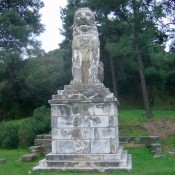Year by year, the acropolis of ancient Amphipolis reveals more of its “secrets”, giving archaeologists and historians the opportunity to obtain important information and knowledge about this famous ancient city which still has a lot to reveal to us, as shown by facts such as the discovery of the burial monument on the Kasta mound.
Moreover, it is no coincidence that during last year’s excavation season completed in August 2021, archaeologists brought to light a new sculpture of a torso wearing a breastplate, attributed to a Roman officer or even to an emperor. The impressive sculpture had been found built into a Byzantine-era wall, in an area covered by rubble of earlier excavations. The breastplate is decorated in relief, with the centre of the motif bearing a victory trophy and to its right and above it a winged victory, a captive with his hands tied behind his back and other figures, among which that of the mythical Hercules.
This year’s fourth excavation period completed at the end of August 2022, brought the archaeologists even closer to their goal, which is to investigate the pre-Christian construction phases on the acropolis of Amphipolis, following the founding of the city in 437 B.C.and after, for which archaeological knowledge is scarce.
The five-year excavation programme on the acropolis of ancient Amphipolis is being conducted as part of the cooperation between the Serres Ephorate of Antiquities and the University of Patras, directed by the head of the Ephorate Dr. Dimitria Malamidou and the professor of classical archaeology Dimitris Damaskos. The monuments that dominate the acropolis today are the enclosure and the five Early Byzantine churches of the 5th and 6th centuries AD. The latter have come to light thanks to earlier excavations under the auspices of The Archaeological Society at Athens.
What did this year’s excavation bring to light?
Everything brought to light by the archaeological dig in this year’s excavation season was presented during an event organized at Eleftheroupolis, the seat of the municipality of Pangaio. Ms. Malamidou presented the main data of the topography of Amphipolis, as well as the spots where the excavation is being conducted, while the professor of the University of Patras Dimitris Damaskos, with origins from Eleftheroupolis, presented the findings of the excavation in detail.
As the two scientists pointed out during the event, this year’s excavation focused on uncovering the Roman building with walls of rough stones, mud bricks and strong lime plaster, situated west of the narthex of the adjacent Proto-Byzantine Basilica III.
To date, the image formed is that of an oblong building 4.50m wide and at least 8.5m long, without its having been fully unearthed since it continues north outside the excavated area. On the inner sides of the walls there are square holes, most probably for the placement of beams. Discovered beneath a layer of fallen roof tiles were iron fittings that suggest a door or hatch.
The part of the destruction layer excavated on this year, contained a number of intact vessels dating to the 2nd and 3rd centuries AD. These were storage vessels and large amphorae, but also smaller everyday table vessels, pots, plates and prochous vases, all carefully placed along the south wall. It is worth noting that some prochous vases with trefoil spouts were saved intact.
According to the archaeologists, the building most probably stopped being used in the Proto- Byzantine years, when part of it was destroyed by a conduit for water drainage from the narthex of the adjacent Basilica. The excavation of the building, whose public or private nature has not yet been clarified, will continue in the next excavation period.
When did Octavian Augustus pass through Amphipolis?
Professor Dimitris Damascos made special reference to last year’s impressive find of the elaborate sculpture of a torso wearing a breastplate, which is now in the process of being conserved in the workshop of the Amphipolis museum, so as to be exhibited at some point. This torso is almost identical to another, found in an earlier excavation, built into the wall of the Byzantine tower of Marmaris in Amphipolis, bearing the same relief decoration, which was identified as the emperor Augustus.
Mr. Damascus pointed out that the representations on the breastplate of the sculpture found last year date to the end of the 1st century B.C. i.e. the era of the first Roman emperor Octavian Augustus who, before ascending the throne, passed through the region of Amphipolis, leading the Roman troops in the battle of Philippi of 42 BC against Brutus and Cassius, the assassins of Julius Caesar. He also noted that Octavian Augustus was honoured by the people of Amphipolis at the end of the 1st century B.C. for reasons that have not yet been investigated.
In closing, he made it clear that he would very much like the torso with the breastplate to belong to Octavian Augustus, as is most likely, however so far this has not been fully established.





